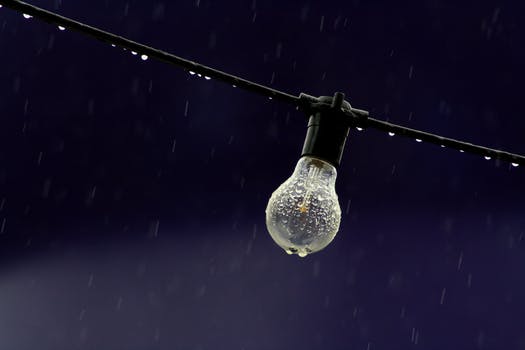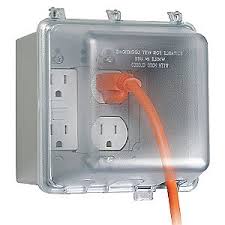One of the modern conveniences of life in an advanced country is the ability to plug our electronics into an electrical outlet while we are outside. It is a benefit that we typically don’t even think about, sometimes to our detriment, as using electricity outdoors carries a few risks that we are better protected from while indoors. Water is the biggest risk factor when outdoors, and should be addressed in a proactive way to protect ourselves and our loved ones from electric shock.

Electrical outlets are (somewhat) open by design, and therefore need to have some type of cover to protect them from getting wet. Outside outlets fall under two different code requirements. Outlets that are protected from direct contact with water by an adequately sized roof/shelter are considered to be a “damp” location. Outlets that can come in contact with water (from rain or other sources) are considered to be a “wet” location.
The code establishes that a damp location is protected from weather and not subject to saturation with water or other liquids, but subject to moderate degrees of moisture. Examples of damp locations include partially protected locations under canopies, roofed open porches and like locations, and interior locations subject to moderate degrees of moisture such as basements and barns.
Outlets that are in “damp” locations are required to be protected by a cover that is weatherproof while it is covering the outlet. These older-style covers are typically spring-loaded with a gasket, and protect the outlet while it is closed. It is common for older covers to experience spring failure and loss or deterioration of the gaskets. These situations both compromise the sealing ability of the cover, and the cover should be repaired or replaced. These covers typically cost between $5-$12 each.

The code establishes that a wet location is any installation that is underground, in contact with concrete slabs or masonry, in contact with the earth, in locations subject to saturation with water or in unprotected locations exposed to the weather.
Outlets that are in “wet” locations are required to be protected by a cover that is weatherproof, regardless of whether or not something is plugged into the outlet. These covers are known by several names, including in-use covers, while in-use covers, extra duty and weatherproof covers. They have expanded plastic covers that allows a cord to be plugged into the outlet while still maintaining a water-proof seal. They typically have tabbed sections on the bottom, while can be easily removed to allow the cord to pass through the closed cover. They typically cost between $10-$20 each.

Installation of these covers is fairly simple, and can be handled by almost anyone with basic handyman skills. To install either of these covers, the old cover must be removed, typically by two small screws. The old cover is removed and the new one is installed, using supplied gaskets to help create a seal. Replacing the two screws completes the installation.
With any electrical work that you attempt yourself, verify that you have turned off the electricity to this fixture prior to beginning work. If necessary, hire a qualified licensed electrical contractor to help complete to job.
